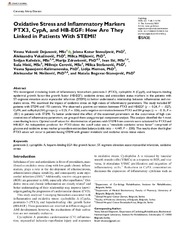| dc.creator | Vuković Dejanović, Vesna | |
| dc.creator | Kotur-Stevuljević, Jelena | |
| dc.creator | Vukašinović, Aleksandra | |
| dc.creator | Miljković, Milica | |
| dc.creator | Kafedžić, Srđan | |
| dc.creator | Zdravković, Marija | |
| dc.creator | Ilić, Ivan | |
| dc.creator | Hinić, Saša | |
| dc.creator | Cerović, Milivoje | |
| dc.creator | Stefanović, Milica | |
| dc.creator | Spasojević-Kalimanovska, Vesna | |
| dc.creator | Memon, Lidija | |
| dc.creator | Nešković, Aleksandar | |
| dc.creator | Bogavac-Stanojević, Nataša | |
| dc.date.accessioned | 2020-06-17T09:45:55Z | |
| dc.date.available | 2020-06-17T09:45:55Z | |
| dc.date.issued | 2020 | |
| dc.identifier.issn | 0003-3197 | |
| dc.identifier.uri | https://farfar.pharmacy.bg.ac.rs/handle/123456789/3612 | |
| dc.description.abstract | We investigated circulating levels of inflammatory biomarkers pentraxin-3 (PTX3), cyclophilin A (CypA), and heparin-binding epidermal growth factor-like growth factor (HB-EGF); oxidative stress; and antioxidant status markers in the patients with ST-segment elevation acute myocardial infarction (STEMI) to better understand a relationship between inflammation and oxidative stress. We examined the impact of oxidative stress on high values of inflammatory parameters. The study included 87 patients with STEMI and 193 controls. We observed a positive correlation between PTX3 and HB-EGF (ρ = 0.24, P = .027), CyPA, and sulfhydryl (SH) groups (ρ = 0.25, P = .026), and a negative correlation between PTX3 and SH groups (ρ = −0.35, P = .001) in patients with STEMI. To better understand the effect of the examined parameters on the occurrence of high concentrations of inflammatory parameters, we grouped them using principal component analysis. This analysis identified the 4 most contributing factors. Optimal cutoff values for discrimination of patients with STEMI from controls were calculated for PTX3 and HB-EGF. An independent predictor for PTX3 above the cutoff value was a “metabolic-oxidative stress factor” comprised of glucose and oxidative stress marker prooxidant-antioxidant balance (odds ratio = 4.449, P = .030). The results show that higher PTX3 values will occur in patients having STEMI with greater metabolic and oxidative stress status values. | en |
| dc.publisher | SAGE journals | |
| dc.relation | info:eu-repo/grantAgreement/MESTD/Basic Research (BR or ON)/175035/RS// | |
| dc.rights | openAccess | |
| dc.rights.uri | https://creativecommons.org/licenses/by-nc-nd/4.0/ | |
| dc.source | Angiology | |
| dc.subject | cyclophilin A | |
| dc.subject | heparin-binding EGF-like growth factor | |
| dc.subject | oxidative stress | |
| dc.subject | pentraxin-3 | |
| dc.subject | ST-segment elevation acute myocardial infarction | |
| dc.title | Oxidative Stress and Inflammatory Markers PTX3, CypA, and HB-EGF: How Are They Linked in Patients With STEMI? | en |
| dc.type | article | |
| dc.rights.license | BY-NC-ND | |
| dcterms.abstract | Богавац-Станојевић, Наташа; Кафедзиц, Срђан; Здравковић, Марија; Илић, Иван; Хинић, Саша; Церовић, Миливоје; Стефановић, Милица; Нешковић, Aлександар; Котур-Стевуљевић, Јелена; Вукашиновић, Aлександра; Миљковић, Милица; Спасојевић-Калимановска, Весна; Мемон, Лидија; Вуковић Дејановић, Весна; | |
| dc.citation.volume | 71 | |
| dc.citation.issue | 8 | |
| dc.citation.spage | 713 | |
| dc.citation.epage | 720 | |
| dc.citation.rank | M22 | |
| dc.identifier.wos | 000533946400001 | |
| dc.identifier.doi | 10.1177/0003319720921724 | |
| dc.identifier.scopus | 2-s2.0-85086022498 | |
| dc.identifier.fulltext | https://farfar.pharmacy.bg.ac.rs/bitstream/id/8061/Oxidative_Stress_and_pub_2020.pdf | |
| dc.type.version | publishedVersion | |

